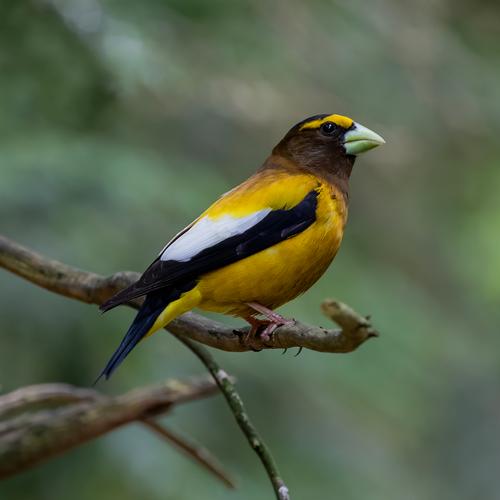Plants and Animals
Coccothraustes vespertinus Evening grosbeak
Key Characteristics
The evening grosbeak is a sexually dimorphic and stocky finch. Adult males are mainly yellow and yellowish brown with black wings and tail, and a white wing patch; head dark with prominent yellow forehead and eyebrow. Females are grayish brown; wings black with white/gray patches, tail black with white tip and white spots. They have a pale greenish yellow bill in spring, which fades to white in fall. Juveniles resemble adult females, though male juveniles are more yellow. Size and coloration easily distinguish this species from other finches in Michigan. Songlike vocalizations from evening grosbeaks have very rarely been observed.
Status and Rank
US Status: No Status/Not Listed
State Status: T - Threatened (legally protected)
Global Rank: G5 - Secure
State Rank: S2 - Imperiled
Occurrences
| County | Number of Occurrences | Year Last Observed |
|---|
Information is summarized from MNFI's database of rare species and community occurrences. Data may not reflect true distribution since much of the state has not been thoroughly surveyed.
Habitat
Evening grosbeaks inhabit a variety of forest types throughout their range, including boreal forests and dry-mesic northern forests. Nesting habitat for this species is associated with forests containing higher proportions of fir and spruce.
Natural Community Types
For each species, lists of natural communities were derived from review of the nearly 6,500 element occurrences in the MNFI database, in addition to herbarium label data for some taxa. In most cases, at least one specimen record exists for each listed natural community. For certain taxa, especially poorly collected or extirpated species of prairie and savanna habitats, natural community lists were derived from inferences from collection sites and habitat preferences in immediately adjacent states (particularly Indiana and Illinois). Natural communities are not listed for those species documented only from altered or ruderal habitats in Michigan, especially for taxa that occur in a variety of habitats outside of the state.
Natural communities are not listed in order of frequency of occurrence, but are rather derived from the full set of natural communities, organized by Ecological Group. In many cases, the general habitat descriptions should provide greater clarity and direction to the surveyor. In future versions of the Rare Species Explorer, we hope to incorporate natural community fidelity ranks for each taxon.
Management Recommendations
Protect and maintain existing mature coniferous and mixed-coniferous forests. Evening grosbeak are sensitive to the loss of mature forest at broad landscape scales, and maintaining large expanses of suitable habitat in areas surrounding occupied forests will benefit this species. Retain spruce, fir, and aspen as preferred tree species. Commercial thinning may benefit this species by promoting well-developed understories that provide potential food sources. Avoid silviculture or harvesting practices that reduce the structural and species diversity of occupied stands.
Management Avoidance Period: From second week of May to second week of August
Active Period
Nesting from second week of May to second week of August
Survey Methods
Surveys for this species are typically point counts or transects through suitable habitat during the breeding season.
Point count, transect
Survey Period: From second week of May to third week of July
Time of Day: Daytime
References
Survey References
- Bibby, C.J., N.D. Burgess, and D.A. Hill. 1992. Bird Census Techniques. Academic Press, New York.
Technical References
- Ng, A. M. B., and A. P. Kortenhoven. 2025. Species Abstract for Coccothraustes vespertinus (evening grosbeak). .


